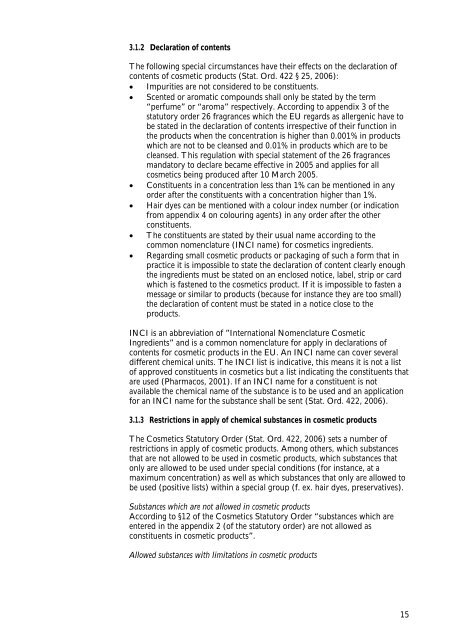A survey and health assessment of cosmetic products for children
A survey and health assessment of cosmetic products for children
A survey and health assessment of cosmetic products for children
You also want an ePaper? Increase the reach of your titles
YUMPU automatically turns print PDFs into web optimized ePapers that Google loves.
3.1.2 Declaration <strong>of</strong> contents<br />
The following special circumstances have their effects on the declaration <strong>of</strong><br />
contents <strong>of</strong> <strong>cosmetic</strong> <strong>products</strong> (Stat. Ord. 422 § 25, 2006):<br />
• Impurities are not considered to be constituents.<br />
• Scented or aromatic compounds shall only be stated by the term<br />
“perfume” or “aroma” respectively. According to appendix 3 <strong>of</strong> the<br />
statutory order 26 fragrances which the EU regards as allergenic have to<br />
be stated in the declaration <strong>of</strong> contents irrespective <strong>of</strong> their function in<br />
the <strong>products</strong> when the concentration is higher than 0.001% in <strong>products</strong><br />
which are not to be cleansed <strong>and</strong> 0.01% in <strong>products</strong> which are to be<br />
cleansed. This regulation with special statement <strong>of</strong> the 26 fragrances<br />
m<strong>and</strong>atory to declare became effective in 2005 <strong>and</strong> applies <strong>for</strong> all<br />
<strong>cosmetic</strong>s being produced after 10 March 2005.<br />
• Constituents in a concentration less than 1% can be mentioned in any<br />
order after the constituents with a concentration higher than 1%.<br />
• Hair dyes can be mentioned with a colour index number (or indication<br />
from appendix 4 on colouring agents) in any order after the other<br />
constituents.<br />
• The constituents are stated by their usual name according to the<br />
common nomenclature (INCI name) <strong>for</strong> <strong>cosmetic</strong>s ingredients.<br />
• Regarding small <strong>cosmetic</strong> <strong>products</strong> or packaging <strong>of</strong> such a <strong>for</strong>m that in<br />
practice it is impossible to state the declaration <strong>of</strong> content clearly enough<br />
the ingredients must be stated on an enclosed notice, label, strip or card<br />
which is fastened to the <strong>cosmetic</strong>s product. If it is impossible to fasten a<br />
message or similar to <strong>products</strong> (because <strong>for</strong> instance they are too small)<br />
the declaration <strong>of</strong> content must be stated in a notice close to the<br />
<strong>products</strong>.<br />
INCI is an abbreviation <strong>of</strong> ”International Nomenclature Cosmetic<br />
Ingredients” <strong>and</strong> is a common nomenclature <strong>for</strong> apply in declarations <strong>of</strong><br />
contents <strong>for</strong> <strong>cosmetic</strong> <strong>products</strong> in the EU. An INCI name can cover several<br />
different chemical units. The INCI list is indicative, this means it is not a list<br />
<strong>of</strong> approved constituents in <strong>cosmetic</strong>s but a list indicating the constituents that<br />
are used (Pharmacos, 2001). If an INCI name <strong>for</strong> a constituent is not<br />
available the chemical name <strong>of</strong> the substance is to be used <strong>and</strong> an application<br />
<strong>for</strong> an INCI name <strong>for</strong> the substance shall be sent (Stat. Ord. 422, 2006).<br />
3.1.3 Restrictions in apply <strong>of</strong> chemical substances in <strong>cosmetic</strong> <strong>products</strong><br />
The Cosmetics Statutory Order (Stat. Ord. 422, 2006) sets a number <strong>of</strong><br />
restrictions in apply <strong>of</strong> <strong>cosmetic</strong> <strong>products</strong>. Among others, which substances<br />
that are not allowed to be used in <strong>cosmetic</strong> <strong>products</strong>, which substances that<br />
only are allowed to be used under special conditions (<strong>for</strong> instance, at a<br />
maximum concentration) as well as which substances that only are allowed to<br />
be used (positive lists) within a special group (f. ex. hair dyes, preservatives).<br />
Substances which are not allowed in <strong>cosmetic</strong> <strong>products</strong><br />
According to §12 <strong>of</strong> the Cosmetics Statutory Order “substances which are<br />
entered in the appendix 2 (<strong>of</strong> the statutory order) are not allowed as<br />
constituents in <strong>cosmetic</strong> <strong>products</strong>”.<br />
Allowed substances with limitations in <strong>cosmetic</strong> <strong>products</strong><br />
15

















